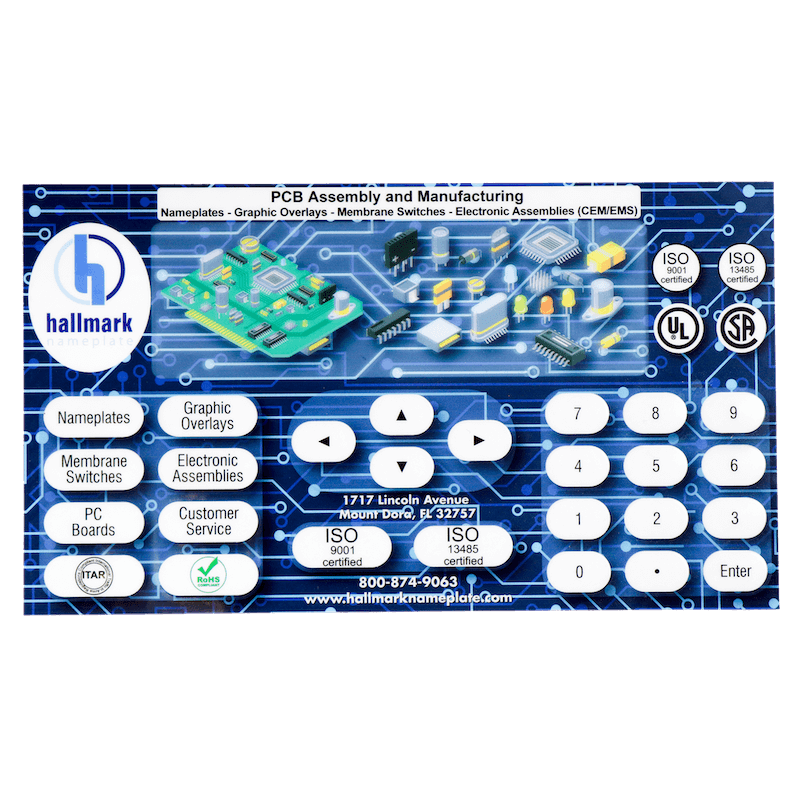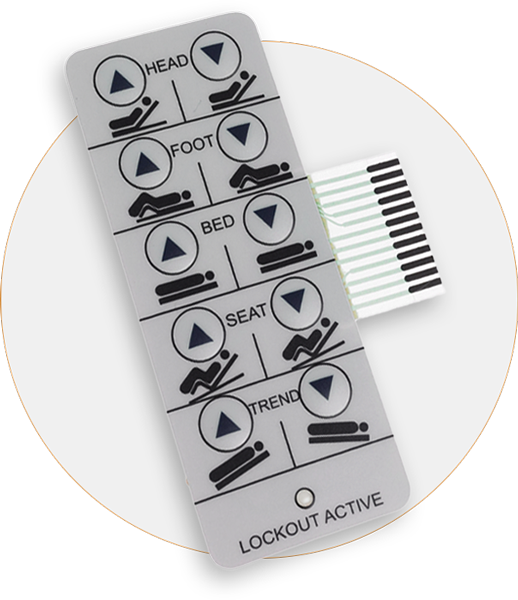How Membrane Switches Are Revolutionizing User Interface Design
Wiki Article
Discover Exactly How Membrane Switches Feature and Their Function in Modern Electronics
Membrane Switches stand for an advanced combination of innovation and design within the realm of modern electronics, serving as necessary interfaces in many gadgets. Understanding the complexities of Membrane button functionality and their broader effects in boosting individual experience invites further expedition right into their layout, advantages, and the ingenious developments shaping their future in technology.
What Are Membrane Switches?

Membrane buttons are identified by their toughness and resistance to environmental elements, such as dirt, wetness, and severe temperatures. They can be customized with numerous graphics, shades, and responsive responses options, boosting individual experience while maintaining aesthetic allure - membrane switches. The unification of published circuits permits for seamless combination right into gadgets, improving total performance.
The flexibility of Membrane buttons appears in their ability to sustain both intricate and easy control functions. They can incorporate attributes such as LED signs and touch-sensitive modern technology, accommodating specific individual requirements. As innovation continues to develop, Membrane Switches continue to be necessary for enabling efficient and instinctive customer interfaces, thus playing a pivotal role in the development of modern-day electronic gadgets.
Parts of Membrane Buttons
Membrane switches are made up of several vital parts that collaborate to create a useful and trusted user interface. The main components consist of the visuals overlay, glue layer, spacer layer, and conductive traces.The visuals overlay acts as the interface, normally printed on a flexible substrate such as polyester or polycarbonate. This layer not just gives visual allure however additionally includes tactile comments, aesthetic signs, and safety attributes. Under the visuals overlay lies the glue layer, which safeguards the switch to the tool and ensures toughness against ecological stress and anxieties.
The spacer layer is crucial for preserving the needed void in between the visuals overlay and the circuit layer. This void permits the activation of the button when stress is used. The conductive traces, normally made from silver or carbon, develop the electric pathways that finish the circuit when the button is involved.
In addition, a backing layer may be consisted of for structural assistance and insulation. These components team up perfectly, ensuring that Membrane buttons are both resilient and easy to use, making them important in numerous modern-day electronic applications.
Just How Membrane Switches Work
How do Membrane Switches function effectively within digital tools? Membrane Switches operate on the principles of pressure-sensitive innovation, using a layered building and construction that includes visuals overlays, sticky layers, and conductive elements.The style of Membrane switches is important for their reliable procedure (membrane switches). The layers are carefully engineered to offer responsive responses, durability, and resistance to environmental variables such as wetness and dust. The incorporation of domes-- tiny, raised locations within the switch-- improves tactile reaction, offering customers with an obvious click experience upon activation
Furthermore, Membrane buttons can be personalized in regards to size, form, and graphics, making them suitable for numerous applications. They are frequently utilized in control panels, medical gadgets, and customer electronics as a result of their smooth style and reliability. On the whole, the effective functioning of Membrane buttons is essential in boosting user communication and making certain smooth operation in modern electronic devices.

Applications in Modern Gadgets
Utilizing their special layout and functionality, Membrane buttons have actually become integral elements in a vast array of modern electronic gadgets. These versatile user interfaces are utilized in consumer electronic devices, commercial tools, medical devices, and automotive controls, giving seamless user interaction.In customer electronics, Membrane switches are typically discovered in home appliances like microwaves, washing devices, and other household devices, where they enable intuitive control with a streamlined profile. Their inconspicuous design facilitates integration right into portable devices, improving aesthetic allure without endangering performance.
In industrial applications, Membrane Switches function as control panels for machinery, offering sturdiness and resistance to extreme settings. Their capacity to endure moisture and pollutants makes them optimal for usage in production and handling markets.
Medical tools likewise gain from Membrane buttons, which are made to be easy to tidy and keep, guaranteeing health in scientific setups. They are frequently used in diagnostic devices, client tracking systems, and mobile medical devices, where dependability is paramount.
Advantages of Membrane Buttons
One of the essential advantages of Membrane switches is their flexibility, which enables them to be tailored for a variety of applications throughout numerous markets. These buttons can be created in different sizes and shapes, accommodating unique product requirements while supplying smooth integration into devices. Their slim account allows a streamlined and small style, usually boosting the visual appeal of electronic products.An additional considerable advantage is their durability - membrane switches. Membrane switches are Learn More generally resistant to dirt, dampness, membrane switches and chemicals, making them ideal for extreme environments. This strength expands their life-span contrasted to standard mechanical buttons, reducing the need for regular substitutes
Furthermore, Membrane Switches offer cost-effectiveness. The manufacturing procedure includes printing technologies that lessen manufacturing costs, specifically for big runs. This affordability, incorporated with low maintenance requirements, makes them an appealing option for suppliers.

Verdict
In verdict, Membrane Switches stand for a considerable advancement in customer interface technology within contemporary electronics. As the need for instinctive and durable interfaces proceeds to expand, the function of Membrane buttons in forming user experience will undoubtedly expand.Membrane Switches stand for a sophisticated combination of modern technology and style within the world of contemporary electronics, offering as essential user interfaces in numerous gadgets.In the world of contemporary electronic devices, Membrane Switches offer as crucial parts that assist in customer interaction with devices. As innovation continues to advance, Membrane Switches stay essential for allowing user-friendly and reliable user interfaces, thereby playing a crucial duty in the innovation of modern-day electronic tools.
Exactly how do Membrane Switches feature properly within electronic tools? Overall, the effective functioning visit site of Membrane switches is essential in enhancing customer interaction and making certain smooth procedure in modern-day digital gadgets.
Report this wiki page